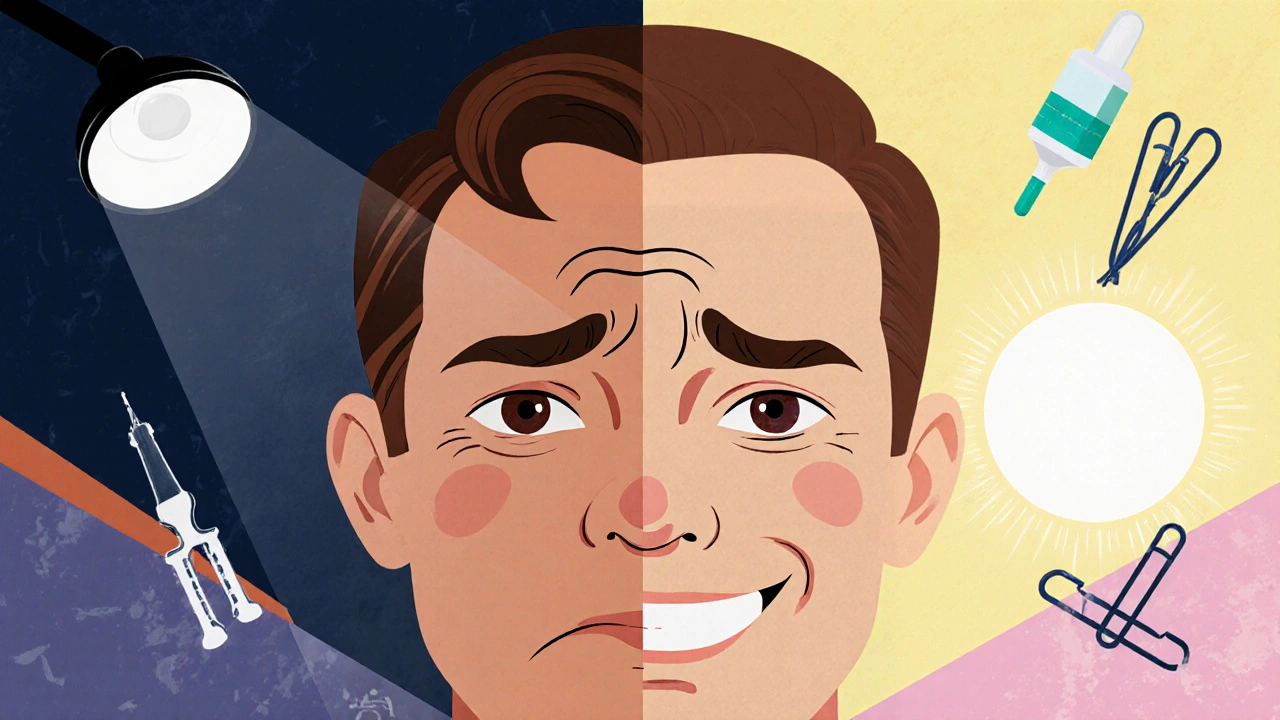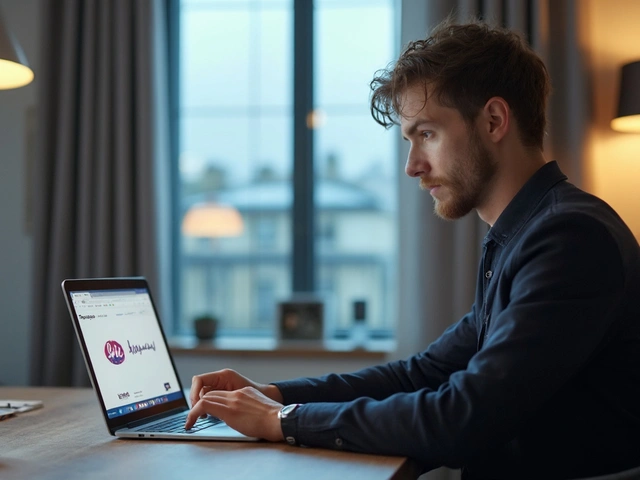Have you ever woken up feeling like your eyelid is too heavy to open? Or noticed your lashes scratching your eye every time you blink? These aren’t just minor annoyances-they could be signs of ptosis or entropion, two common but serious eyelid disorders that can affect vision and eye health if left untreated.
What Is Ptosis? When Your Eyelid Drops Too Low
Ptosis is when the upper eyelid droops over the eye, sometimes covering part or all of the pupil. It can happen in one or both eyes. You might not even notice it at first-just that you’re raising your eyebrows more than usual to see clearly, or that your eyes feel tired by midday. This isn’t just about looks. When the eyelid drops too far, it blocks your vision. People with ptosis often develop headaches from straining to keep their eyes open. In children, untreated ptosis can lead to lazy eye (amblyopia). In adults, it’s most often caused by aging. As we get older, the muscle that lifts the eyelid-the levator-stretches and weakens. About 5% of people over 70 have some degree of ptosis. Other causes include nerve damage, trauma, long-term contact lens wear (which increases risk by about 30%), or even genetics. If your eyelid suddenly droops over a few hours or days, that’s a red flag. Rapid onset can signal a neurological issue like a stroke or aneurysm, and needs immediate evaluation. Doctors measure ptosis using the margin reflex distance (MRD), which checks how far the eyelid edge is from the center of the pupil. A normal MRD is 4-5 mm. Mild ptosis is a 1-2 mm droop, moderate is 2-3 mm, and severe is more than 3 mm-meaning the eyelid is covering a large part of your vision.What Is Entropion? When Your Eyelid Turns Inward
Entropion is the opposite problem: the eyelid, usually the lower one, rolls inward so your eyelashes rub against your eyeball. Imagine sandpaper gently scraping your cornea every time you blink. That’s what it feels like. Symptoms include constant irritation, redness, tearing, mucus discharge, and a gritty feeling like something’s stuck in your eye. Left unchecked, this constant friction can cause corneal abrasions, ulcers, and even permanent vision loss. It’s a sight-threatening condition. The most common type is involutional entropion-age-related. As we age, the tendons and muscles around the eyelid loosen. Gravity pulls the lid down, and without proper support, it curls inward. About 80% of entropion cases in Western countries are this type. It’s rare under 50, but jumps to 2.5% in people over 80. Other causes include scarring from burns, infections like trachoma (still common in areas with poor sanitation), previous eye surgeries, or chronic inflammation like blepharitis. Trichiasis-misdirected eyelashes from damaged follicles-is often part of the picture. It’s not the same as entropion, but it causes similar damage and often occurs alongside it.How Are These Conditions Diagnosed?
Your eye doctor won’t just look at your eyelids-they’ll test how well they work. For ptosis, they’ll check your levator muscle strength. If it’s weak, they might use a phenylephrine eye drop to see if the lid lifts temporarily. That helps decide which surgery is best. For entropion, they’ll gently pull on your eyelid to test its tone and elasticity. They’ll also check for scarring, inflammation, or signs of infection. If you have both ptosis and entropion-which isn’t uncommon-it’s important to treat both. One problem can mask or worsen the other. Blepharitis, a chronic inflammation of the eyelid margins, is often present too. It’s not a cause of ptosis or entropion, but it makes symptoms worse. Oil glands at the base of your lashes get clogged, leading to crusty, red lids. Managing it with warm compresses and eyelid scrubs is part of the treatment plan, even before surgery.
Surgical Repair: What to Expect
If conservative treatments like lubricating drops, eyelid taping, or treating blepharitis don’t help, surgery is the only lasting fix. For ptosis, there are three main procedures:- Levator resection: Used for moderate to severe ptosis when the levator muscle still has some strength (more than 4 mm of movement). The surgeon shortens the muscle to lift the lid. Success rates are 85-95% for first-time surgeries.
- Frontalis sling: For severe ptosis with very weak levator function (less than 4 mm). The eyelid is connected to the forehead muscle so you raise your brow to lift your lid. Common in children or people with nerve damage.
- Müller’s muscle-conjunctival resection: For mild ptosis. It’s less invasive and works best if the eyelid responds to phenylephrine. Recovery is quick, with little swelling.
What Are the Risks of Surgery?
Surgery is generally safe, but complications happen. For ptosis:- Overcorrection (eyelid too high): 5-10%
- Undercorrection (eyelid still droopy): 3-8%
- Lid asymmetry: 5-15%
- Dry eye: 10-20%
- Recurrence: 5-15% (higher if scarring is involved)
- Scarring: 2-5%
- Infection: 1-3%
Who Needs Surgery? When to Act
Not everyone with mild ptosis or occasional eyelid irritation needs surgery. But here’s when you should consider it:- Your vision is blocked, even slightly
- You have constant eye pain, redness, or discharge
- Your eyelashes are scratching your cornea
- You’ve tried eye drops and hygiene for weeks with no improvement
- You’re developing a corneal ulcer or abrasion

What You Can Do Before Surgery
You don’t have to wait for surgery to feel better. Here’s what helps right now:- Use preservative-free artificial tears 3-4 times a day to protect the cornea
- Apply a thin layer of ophthalmic ointment at night
- Tape your eyelid gently upward with medical tape (available at pharmacies)
- Do warm compresses twice daily for 5-10 minutes to loosen clogged oil glands
- Clean your eyelids with a gentle lid scrub or diluted baby shampoo on a cotton swab
The Bigger Picture: Why This Matters
The global market for eyelid surgery is growing fast-projected to hit $2.7 billion by 2028. Why? Because people are living longer. As life expectancy rises, so do age-related eyelid disorders. About 15-20% of all oculoplastic surgeries in the U.S. are for ptosis or entropion. These aren’t cosmetic procedures. They’re functional. They restore vision. They prevent blindness. They improve quality of life. If you’re over 60 and your eyelids feel heavy, or your eyes are constantly irritated, don’t brush it off as "just getting old." See an eye specialist. Early diagnosis means simpler treatment, fewer complications, and better outcomes.Frequently Asked Questions
Can ptosis go away on its own?
No, ptosis does not resolve on its own. It’s caused by physical changes in the eyelid muscle or nerve control, which don’t reverse naturally. While mild cases may not need immediate surgery, they won’t improve without treatment. Waiting too long can lead to eye strain, headaches, or even vision loss in children.
Is entropion dangerous if left untreated?
Yes. Entropion causes your eyelashes to rub against your cornea, which can lead to corneal abrasions, ulcers, infections, and permanent scarring. In severe cases, this results in vision loss. It’s one of the few eyelid conditions that can cause blindness if ignored. Prompt treatment is critical.
Can blepharitis cause ptosis or entropion?
Blepharitis doesn’t directly cause ptosis or entropion, but it can worsen them. Chronic inflammation weakens eyelid tissues, makes scarring more likely, and increases the risk of trichiasis (misdirected lashes). Managing blepharitis with daily lid hygiene is essential before and after surgery to prevent recurrence.
How long does recovery take after eyelid surgery?
Recovery varies by procedure. For levator resection or tarsal fracture surgery, most people return to normal activities in 1-2 weeks. Swelling and bruising fade within 10-14 days. Newer minimally invasive techniques using absorbable sutures can cut recovery to just 7-10 days. Full healing takes 4-6 weeks, but vision and comfort improve quickly.
Are there non-surgical options for entropion?
Temporary relief is possible with lubricating drops, taping the eyelid, or removing misdirected lashes with epilation or electrolysis. But these don’t fix the structural problem. For lasting results, surgery is the only option. Non-surgical methods are used to protect the eye while waiting for surgery or for patients who can’t undergo anesthesia.
Can I wear contact lenses after eyelid surgery?
You should avoid contact lenses for at least 2-4 weeks after surgery, depending on your healing. Wearing them too soon can irritate the eye, delay healing, or increase infection risk. Your surgeon will give you a timeline based on your procedure. Many patients switch to glasses during recovery.






Gabe Solack
17 November 2025 - 20:07 PM
Just had ptosis surgery last month-life-changing. I used to have to constantly lift my brow just to see my phone. Now? No more headaches, no more squinting. 🙌 The recovery was way easier than I expected. Just stick to the artificial tears and don’t rush the healing. Seriously, if you’re even thinking about it-do it.
Katelyn Sykes
18 November 2025 - 01:52 AM
My grandma had entropion and she refused surgery for years because she thought it was just 'old age stuff'. Ended up with a corneal ulcer and nearly lost her eye. Don't wait. If your lashes are scraping your eyeball, that's not normal. Get it checked. Warm compresses help but they're just bandaids. Surgery fixes it.
Denny Sucipto
18 November 2025 - 15:47 PM
Bro I felt this so hard. I used to tape my eyelid up with medical tape just to drive at night. Felt like I was in a slow-motion movie where everything was just… out of reach. I didn’t even realize how much I was straining until I had the surgery. Now I look in the mirror and think ‘who is this person who doesn’t look exhausted all the time?’
Heidi R
19 November 2025 - 20:04 PM
Of course it’s a $2.7B market. They’re not fixing vision-they’re selling ‘youth’ disguised as function. You’re not ‘getting old,’ you’re being sold a procedure. Just wear sunglasses and stop staring at screens. Problem solved.
Brenda Kuter
21 November 2025 - 19:16 PM
EVERYONE knows the FDA is hiding the truth about contact lenses causing ptosis. My cousin’s eye doctor told her it was ‘genetics’ but she found a whistleblower blog that said Big Pharma pumps out lenses that weaken the levator muscle. They don’t want you to know. They profit off the surgeries. I’m not getting one. I’m using copper wire and prayer now. 🤡
Yash Nair
22 November 2025 - 15:03 PM
USA always overmedicalize everything. In India we just use turmeric paste and blink slowly. No surgery needed. People here think a droopy eyelid is a crisis. We have people with 50% vision loss and they just laugh and keep working. Why are you so weak?
Emanuel Jalba
24 November 2025 - 07:02 AM
THIS IS A GOVERNMENT COVERUP. Why do you think they added ‘adjustable sutures’ in 2018? So they could charge more. They know people will pay extra to ‘fine-tune’ their eyelids. It’s all about the money. I’ve been using a magnet taped to my forehead for 3 months. My eyelid is now slightly higher. Science? No. Soul.
Iska Ede
25 November 2025 - 21:21 PM
So let me get this straight-you’re telling me I can pay $5K to stop looking like I’m perpetually mad at my ex? Sign me up. I’ve been raising my eyebrows so much my forehead looks like a crumpled paper bag. I’m booking the appointment tomorrow. Also, anyone know a good surgeon who doesn’t judge my eyeliner?
Holly Powell
25 November 2025 - 22:48 PM
Interesting that the article mentions ‘involutional entropion’ as if it’s a benign inevitability. But the data is cherry-picked. Only 80%? What about the cohort with systemic collagen disorders? You’re omitting the epigenetic triggers linked to prolonged screen exposure post-2010. The real epidemic is digital ocular dystrophy. And no one’s talking about it.
Girish Pai
26 November 2025 - 13:16 PM
From an oculoplastic standpoint, the tarsal fracture procedure remains the gold standard for involutional entropion with >90% efficacy. However, newer absorbable suture techniques demonstrate non-inferiority in RCTs with lower postoperative edema. The key variable is orbicularis oculi tone-assessed via the snap-back test. If you’re over 75 and have laxity >2mm, you’re a candidate.
Shaun Barratt
26 November 2025 - 22:50 PM
It is imperative to note that the margin reflex distance (MRD) must be measured under standardized lighting conditions, with the patient in a neutral head position, and with the use of a calibrated slit-lamp biomicroscope. Failure to adhere to these parameters may result in diagnostic misclassification. Additionally, phenylephrine testing should be conducted prior to surgical planning to assess Müller’s muscle function accurately.
Christine Eslinger
27 November 2025 - 16:15 PM
My mom had this surgery at 72. She cried because she could finally see her grandkids’ faces without squinting. It wasn’t about looking younger-it was about being present. We all think aging means giving up things, but sometimes it just means letting go of the idea that suffering is normal. You don’t have to live with a scratchy eye. You deserve to blink without pain.
Shilpi Tiwari
27 November 2025 - 18:14 PM
Trachoma-related entropion is still endemic in rural India. The WHO estimates 1.9 million cases globally. Most cases go untreated due to lack of access. We need mobile surgical units, not just fancy adjustable sutures in Beverly Hills. Why is the article silent on global inequity? This isn’t just a ‘getting old’ issue-it’s a public health crisis.
Gabriella Jayne Bosticco
28 November 2025 - 07:50 AM
My eyelid’s been drooping since I had my third kid. Taped it up last night and slept without headaches for the first time in years. I’m not doing surgery yet-I’m just waiting until I’m ready. But this post? Perfect. Just needed someone to say it’s okay to not just ‘live with it’.